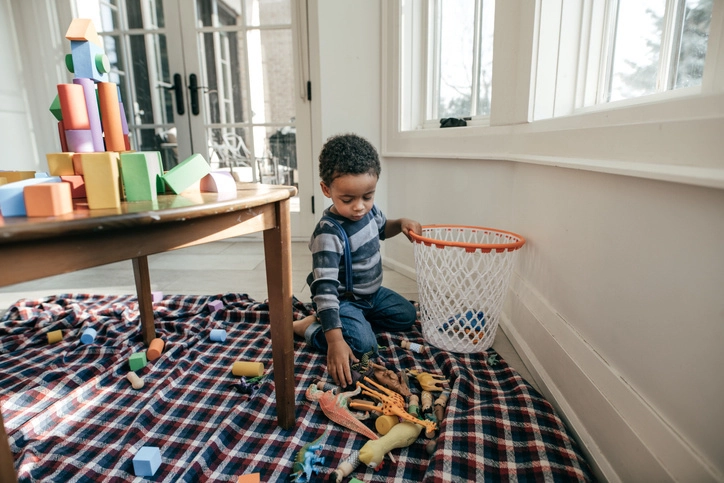
There are a few things teachers at daycare encourage in even the youngest children to put away their things when they’re done using them. Here are some tips from daycare:
1. Create a place for everything
While it seems like it would be easier for children to put away their toys if they simply had to dump everything into a big toy bin, this isn’t generally the case. Young children have a powerful sense of order—they like things to be just so. Because of this, many children get immense satisfaction from returning something to its precise spot. They are more likely to clean up their toys if each toy has a designated place where it belongs. To try this, you may have to put away some of your child’s toys. Spend some time observing your child to see what they really like to play with. If there’s something they haven’t touched in a week, put it away in a closet for a later time , or give it away if you think they’ve outgrown it. Then arrange the remaining toys on a shelf so that each item has a clear spot. Make sure the shelf is not crowded. Your child may surprise you by starting to put their toys away on their own, now that they know exactly where to put something.
2. Model from a young age
With babies and very young toddlers, the best way to encourage them to clean up their toys is to model it. Don’t save cleanup for nap time—make it a part of the process you complete together. Your baby will watch you, and your toddler will likely join in. If they don’t, give it time. They are much more likely to help if it seems like a natural task you complete together than if you demand that they do it and it becomes a power struggle . If you have an older child, that’s fine too! It’s never too late to model how to clean up. You may be doing most of the work in the beginning, but you can gradually step back and encourage your child to be a more active participant.
3. Make expectations clear
Decide what expectations you have for your child regarding clean up and make them explicit. Do you want them only to use one toy at a time and then put it away or are you okay with them mixing toys? Are they allowed to leave out a big project, like a Lego creation in progress, overnight or does everything get put away at the end of the day? If you have more than one child, who cleans up if they’re playing dolls together, but one child moves on to play something else while the other keeps playing? The rules you choose are less important than the consistency with which you enforce them. Choose a few rules that are important to you, share them with your children, and remind them frequently until they internalize the new expectations.
4. Make it a game
“I wonder how many red blocks you can find to put in the bucket?” “I wonder if you can put ALL the toys away before Happy and you Know it stops playing?” “I wonder if you can fit every block into the bucket?” I admit, it can be hard to muster the energy to turn clean-up into a game sometimes, but if you have it in you, give it a try. It can quickly turn the worst part of the day into one of the best.
5. Frame it in a positive way
Instead of, “No lunch until your toys are cleaned up!” try saying, “After you put your toys away, we can have lunch together.” Often highlighting what comes next is a great incentive for kids to put their things away. It helps them mentally transition to what comes next and gives them something to look forward to.
6. Wait for a natural break
No one likes to be interrupted, and kids are no exception. While it isn’t always possible, try to wait until your child reaches a natural pause in what they are doing to ask them to clean up. Let them finish that one drawing. Let them put the last few blocks on his tower. Let them finish making their mud pie. It can be automatic to ask our children to clean up when we have lunch ready or when it’s time for a nap, but try to ask yourself first, can this wait five minutes? The thing is, it will often be quicker to let them finish what they are doing than to interrupt and ask them to clean up right away. If you are on a tight timeline and you need to interrupt, be prepared to help a little more with clean up. No parent wants to spend the precious nap time or post-bedtime hours picking up toys, and you don’t have to. No matter what age your child is, you can set clear expectations that they put away their things. It may take some practice and some patience, but they will get on board soon if you are consistent and make it as collaborative as possible. You’ve got this mama!
Article and Image Source: Christina Clemer | Motherly
____
Discovery Point Nursery and Academy – Vaughan daycare in Woodbridge, Ontario